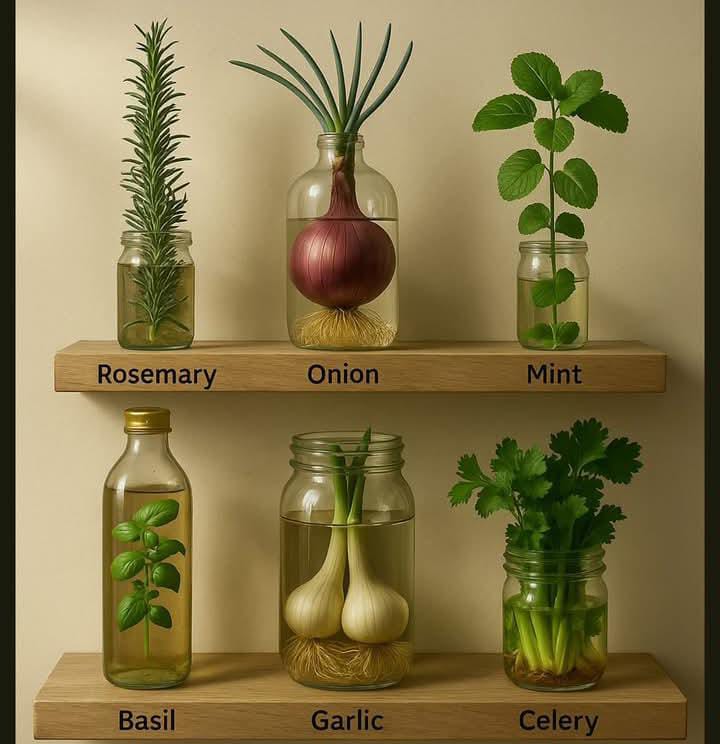The Ultimate Guide: Plants You Can Grow in Water in Your Kitchen (No Soil Needed!)
If you’ve ever wanted to grow your own herbs and vegetables but don’t have access to a garden, or simply want something low-maintenance, then this guide is for you. Growing plants in water—also known as hydroponic gardening—is one of the easiest and most space-efficient ways to keep fresh, edible greenery right in your kitchen.
With just a few everyday tools (like jars or cups), some clean water, and a sunny windowsill, you can build a vibrant, living indoor garden. These plants not only provide fresh flavor for your meals but also bring life, fragrance, and a touch of nature into your home.
Let’s dive deep into the plants you can grow in water and how to care for them like a pro.
Why Grow Plants in Water?
Before we get into the plants themselves, let’s talk about why growing in water is a great option:
No Soil, No Mess
You don’t have to deal with dirt, pots, or garden pests. Water gardening is clean and hassle-free.
Space-Saving
Perfect for small apartments, kitchen counters, or windowsills. No backyard needed!
Easy Maintenance
Once you get it set up, there’s minimal upkeep. Just change the water regularly and provide some sunlight.
Always Fresh
You’ll always have fresh herbs and greens at your fingertips—no more last-minute grocery runs!
Beautiful & Functional
A row of jars with growing green herbs looks beautiful and smells amazing. It’s decor with purpose.
Top 6 Plants You Can Grow in Water (Step-by-Step Instructions)
1. Rosemary
Why It’s Great:
Rosemary is a hardy, aromatic herb that’s a staple in many kitchens. Its woody stems and fragrant leaves make it ideal for cooking and easy to root in water.
How to Grow It in Water:
- Take a 4–6 inch cutting from a healthy rosemary plant.
- Remove the lower leaves, especially the ones that would sit in water.
- Place the cutting in a glass jar or bottle filled with fresh water.
- Keep the jar in a warm, sunny location—like a kitchen windowsill.
- Change the water every few days.
- In 2–4 weeks, you’ll see roots forming. When the roots are about 2 inches long, the plant is ready to be used or transferred to soil.
Use It For: Roasted vegetables, meat marinades, bread dough, or infused oils.
2. Onion
Why It’s Great:
Onions are incredibly easy to regrow from kitchen scraps. They grow quickly and provide fresh green shoots that are similar to scallions.
How to Grow It in Water:
- Slice off the bottom 1 inch of an onion (the root part).
- Place it in a shallow bowl or dish with the root side down.
- Add just enough water to cover the base.
- Place in a sunny spot.
- Within a few days, you’ll see green shoots emerging from the top and roots growing underneath.
- Replace the water regularly to keep it fresh.
Use It For: Topping soups, salads, eggs, or stir-fries.
3. Mint
Why It’s Great:
Mint is one of the fastest-growing herbs in water. It also smells amazing and is incredibly versatile in the kitchen.
How to Grow It in Water:
- Cut a few healthy sprigs from an existing mint plant, about 4–5 inches long.
- Remove the leaves from the bottom half of the stem.
- Place the stems in a glass of water and keep it in a bright spot with indirect sunlight.
- Change the water every 2–3 days.
- Roots will begin to form in less than a week. You’ll soon have a full bush of mint ready to harvest.
Use It For: Teas, mojitos, salads, desserts, and as garnish.
4. Basil
Why It’s Great:
Fresh basil is a kitchen essential. It adds bold flavor to so many dishes and grows easily in water from cuttings.
How to Grow It in Water:
- Take a 4–6 inch cutting from a basil plant, just below a node (where leaves grow).
- Remove the lower leaves and place the stem in a clear jar of water.
- Keep the jar in a sunny window.
- Change the water every 2–3 days to prevent mold or algae.
- After a week or two, roots will form and the plant will start to grow new leaves.
Use It For: Pasta, pizza, pesto, caprese salad, and sauces.
5. Garlic
Why It’s Great:
Even if you don’t get full bulbs from garlic in water, you’ll still get tasty garlic greens that have a mild, chive-like flavor.
How to Grow It in Water:
- Place a few garlic cloves (unpeeled, with root ends intact) in a small dish with the root end down.
- Add enough water to cover just the bottom of the cloves.
- Set in a sunny window.
- Green shoots will start to appear within 7–10 days.
- Change the water every 2 days to keep the cloves fresh.
Use It For: Salads, soups, egg dishes, or anywhere you’d use scallions or chives.
6. Celery
Why It’s Great:
Celery is fun to grow and regenerates quickly. You won’t get full-size stalks indoors, but the new greens and baby stalks are tasty and decorative.
How to Grow It in Water:
- Cut off the bottom 2 inches of a celery bunch.
- Place it root-side down in a shallow bowl with water.
- Put it in a sunny spot like a windowsill.
- In a few days, new leaves will begin to sprout from the center.
- As it grows, you can trim the leaves and smaller stalks to use in your cooking.
Use It For: Salads, soups, juices, and garnish.
Extra Tips for Growing Plants in Water
- Water Quality Matters
Use filtered or dechlorinated water when possible. Tap water with too much chlorine can harm delicate plants. - Use Clear Containers
Glass jars are best because you can see the roots and monitor water clarity. Avoid metal containers that can corrode. - Location is Key
Place jars near windows that get indirect sunlight. Too much direct sunlight can cause algae growth or burn the plants. - Change Water Frequently
Old water can grow bacteria and mold. Fresh water every 2–3 days keeps the roots healthy. - Harvest Regularly
Don’t let your plants grow too wild. Regular trimming encourages new growth and prevents legginess. - No Fertilizer? No Problem
Most herbs can survive without fertilizer in water for weeks, but if you want faster growth, you can add a drop of liquid hydroponic fertilizer once a week.
Final Thoughts
Growing herbs and vegetables in water is more than just a fun experiment—it’s a smart, sustainable way to keep fresh, flavorful ingredients close at hand. Whether you’re a home cook, a plant lover, or just someone looking to brighten up the kitchen, this method is easy, low-maintenance, and incredibly rewarding.
With just a few cuttings and containers, you can turn a corner of your kitchen into a lush little indoor garden. So grab a jar, fill it with water, and start growing today!


